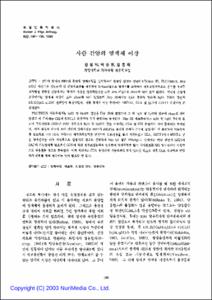사람 간암의 염색체 이상
- Affiliated Author(s)
- 장성익
- Alternative Author(s)
- Chang, Sung Ik
- Journal Title
- 대한체질인류학회지
- ISSN
- 1225-150X
- Issued Date
- 1995
- Abstract
- To a better understanding for molecular mechanism of oncogenesis in hepatoma, primary hepatocellular carcinoma and hepatoma cell lines(Hep 3B, PLC/PRF/5, Hep G2) were subjected to detailed cytogenetic analysis with G-banding method after cell cultures. No cloned chromosomal abnormalities were found in the primary hepatoma(below 10%). On the other hand, all hepatoma cell lines were cloned, the specific chromosomal abnormalities in Hep 3B were del(1p21), del(6q14) and t(1, 11)(p11; q13) Genes of AMY1A, CGA, SEA and HSTF1 were located on 1p21 and 6q14 respectively, SEA and HSTF1 were located on 11q13. Regions of chromosome abnormalities in PLC/PRF/5 were the same found in Hep 3B. Besdies, del(1q32) and del(1p32) were also cloned Gene of CR1 and MYCL1 were located on 1q32 and 1p32 respectively The characteristic findings of chromosome abnormalities in Hep G2 were del(1p31) and del(1q22) And GST1 and DAF were located on these regions each other. Del(6q11) and del(1p22) were also found in Hep G2 From the above results, it is presumed that HBV may integrate to AMY1A gene or near this gene and leads to loss of functions to this gene And impaired regulation of CGA occurs in next step. SEA, HSTF1 and MYCL1 oncogenes may act as a progressing factor of tumourgenesis in HBsAg( + ) hepatoma. Some factors like chemical agents may cause functional loss of GST1 and DAF at first and functional loss of cell regulation of CGA occurs m next step SKI oncogene may promote the progression of carcinogenesis in this cell line. Whether any causative agents are involed in carcinogenesis of hepatoma, fuctional loss of CGA gene is the most important factor in tumour-genesis in hepatoma.
간암에 있어서 HBV와 관련된 암화과정을 알기위하여 원발성 간암과 간암 세포 주(Hep 3B PLC/PRF/5 Hep G2)를 대상으로 간암조직 및 간암 세포 주를 배양하여 G-band법으로 염색체를 조작하여 세포유전학적으로 분석한 결과를 요약하여 원발성 간암에서는 염색체 이상은 발견되었지만 모두 10% 미만으로 clone화 되어 있지 않았다. 반면에 간암 세포 주에서는 염색체 이상이 모두 clone화 되어 있었는데 Hep 3B 에서는 1p21 부위의 결손과 6q14 부위의 결손과 t(1;11)(p11, q13)의 전좌형이 특징 이었다. 이들 염색체 이상 부위에는 AMY1A CGA 및 SEA 와 HSTF1 유전자가 존재하였다.
PLC/PRF/5 세포 주에서는 1p21 및 6q14의 결손은 Hep 3B와 같았으며 그 외 1q32 및 1p32의 결손이 clone화 되어 있었고 이 부위에는 CRI과 MYCL1 유전자가 각각 존재하는 부위였다. Hep G2 세포 주에서는 1p31 및 1q22 부위의 결손이 특징이었고 GST1과 DAF 유전자가 6q11 및 1p22의 결손 부위에는 CGA 및 SKI 유전자가 각각 존재하는 부위였다. 위의 결과로 미루어 보아 간암의 암화과정은 HBV가 AMY1A 유전자 부위나 근처에 삽입되어 이 유전자의 기능장애를 일으키고 다음 CGA 유전자가 세포조절능력을 상실시켜 암화과정을 밟기 시작하였고 SEA HSTF1이나 MYCL1 같은 암유전자는 더욱 악성 쪽으로 진행시킨 것으로 생각되며 Hep G2 같은 HBsAg(-) 암에서는 어떤 원인이 GST1 과 DAF에 기능장애를 일으켜서 CGA에 의한 세포조절능력을 상실하여 암화과정을 밟기 시작하였고 SKI 암유전자가 악성 쪽으로 작용했을 것으로 추측된다. 어떤 원인이든 CGA 유전자의 기능장애와 관계 있는 듯 하므로 향후 CGA 유전자와 간암과의 관계를 계속 연구하는 것이 필요할 것 같다
- Alternative Title
- Chromosomal Abnormalities in Human Hepatoma
- Department
- Dept. of Anatomy (해부학)
- Publisher
- School of Medicine
- Citation
- 장성익 et al. (1995). 사람 간암의 염색체 이상. 대한체질인류학회지, 8(2), 185–193.
- Type
- Article
- ISSN
- 1225-150X
- Appears in Collections:
- 1. School of Medicine (의과대학) > Dept. of Anatomy (해부학)
- 파일 목록
-
-
Download
 oak-bbb-3751.pdf
기타 데이터 / 669.43 kB / Adobe PDF
oak-bbb-3751.pdf
기타 데이터 / 669.43 kB / Adobe PDF
-
Items in Repository are protected by copyright, with all rights reserved, unless otherwise indicated.